Expert Minds
Hello, my documents are 100% guaranteed to help you Ace in your studies, my goal is to empower and help you in your career, i represent more professional nursing specialties and other courses.
I'm a friendly person, don't hesitate to contact me.
Good luck
- 2387
- 0
- 165
Community
- Seguidores
- Siguiendo
333 Comentarios recibidos
2585 artículos
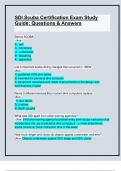
Study Guide: SDI Scuba Certification Exam Study Guide: Questions & Answers: Latest Updated: Guaranteed APlus Guide
Name 3 different devices that modern dive computers replace (Ans- 1) dive tables 2) J-valves 3) depth gauges What sets SDI apart from other training agencies? (Ans- First dive training agency to provide entry level scuba instruction that incorporates the use of personal dive computers --> more streamlined scuba course w/ more instruction time in the water How much larger and closer do objects appear underwater and why? (Ans- Objects underwater appear 25% larger and 25% closer...
- Package deal
- Examen
- • 14 páginas •
Name 3 different devices that modern dive computers replace (Ans- 1) dive tables 2) J-valves 3) depth gauges What sets SDI apart from other training agencies? (Ans- First dive training agency to provide entry level scuba instruction that incorporates the use of personal dive computers --> more streamlined scuba course w/ more instruction time in the water How much larger and closer do objects appear underwater and why? (Ans- Objects underwater appear 25% larger and 25% closer...
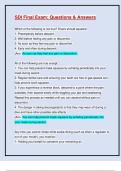
Final Exam:SDI:SDI Final Exam 100% Verified Questions & Answers: Latest Updated A Plus Score Solution
Which of the following is not true? Divers should equalize: 1: Preemptively before descent. 2: Well before feeling any pain or discomfort. 3: As soon as they feel any pain or discomfort. 4: Early and often during descent. (Ans- As soon as they feel any pain or discomfort. Objects under water appear: 1: The same size as they do on land. 2: Twice as large as they do on land. 3: Closer and larger than they do on land. 4: Smaller and farther away than they do on land. (Ans- Closer and...
- Package deal
- Examen
- • 27 páginas •
Which of the following is not true? Divers should equalize: 1: Preemptively before descent. 2: Well before feeling any pain or discomfort. 3: As soon as they feel any pain or discomfort. 4: Early and often during descent. (Ans- As soon as they feel any pain or discomfort. Objects under water appear: 1: The same size as they do on land. 2: Twice as large as they do on land. 3: Closer and larger than they do on land. 4: Smaller and farther away than they do on land. (Ans- Closer and...
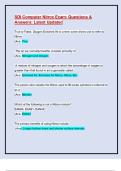
Latest Updated) SDI Computer Nitrox Exam: 100 % Verified Questions & Answers; Guaranteed APlus Score
True or False. Dive computers work by monitoring the presences of so-called 'silent bubbles using ultrasound. (Ans- False What may happen if you go too deep or stay too long? (Ans- You may not be able to make a direct ascent to the surface without substantially increasing your risk of decompression sickness and your dive computer may require you to make a series of decompression stops A decompression stop is: (Ans- Pausing at a fixed depth for a specified period of time to allow exc...
- Package deal
- Examen
- • 8 páginas •
True or False. Dive computers work by monitoring the presences of so-called 'silent bubbles using ultrasound. (Ans- False What may happen if you go too deep or stay too long? (Ans- You may not be able to make a direct ascent to the surface without substantially increasing your risk of decompression sickness and your dive computer may require you to make a series of decompression stops A decompression stop is: (Ans- Pausing at a fixed depth for a specified period of time to allow exc...

Exam 1: Exam 2: Exam 3: Bios 255 : Questions & Answers : Updated APlus Solutions
what are 3 'systems' of blood circulation that we discussed in class? (Ans- pulmonary system systemic system coronary system during ventricular systole, what is happening to the blood volume within the ventricle? (Ans- first, there is no change-once pressure is great enough and the semilunar valves one, volume drops what 3 veins empty into the right atrium (Ans- superior vena cava, inferior vena cava, coronary sinus an individual has an increase in afterload, what effect wo...
- Examen
- • 31 páginas •
what are 3 'systems' of blood circulation that we discussed in class? (Ans- pulmonary system systemic system coronary system during ventricular systole, what is happening to the blood volume within the ventricle? (Ans- first, there is no change-once pressure is great enough and the semilunar valves one, volume drops what 3 veins empty into the right atrium (Ans- superior vena cava, inferior vena cava, coronary sinus an individual has an increase in afterload, what effect wo...
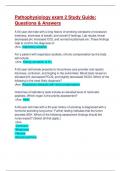
Pathophysiology Exam 2: Study Guide: Questions & Answers: Latest Updated
A 54-year-old male with a long history of smoking complains of excessive tiredness, shortness of breath, and overall ill feelings. Lab results reveal decreased pH, increased CO2, and normal bicarbonate ion. These findings help to confirm the diagnosis of: (Ans- respiratory acidosis For a patient with respiratory acidosis, chronic compensation by the body will include: (Ans- Kidney excretion of H+ A 55-year-old female presents to her primary care provider and reports dizziness, confusio...
- Examen
- • 42 páginas •
A 54-year-old male with a long history of smoking complains of excessive tiredness, shortness of breath, and overall ill feelings. Lab results reveal decreased pH, increased CO2, and normal bicarbonate ion. These findings help to confirm the diagnosis of: (Ans- respiratory acidosis For a patient with respiratory acidosis, chronic compensation by the body will include: (Ans- Kidney excretion of H+ A 55-year-old female presents to her primary care provider and reports dizziness, confusio...
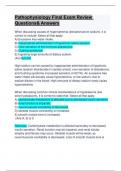
Pathophysiology Final Exam Review: Questions& Answers; Updated A Guide Solution
When discussing causes of hypernatremia (elevated serum sodium), it is correct to include: Select all that apply. A) Excessive free water intake. B) Inappropriate administration of hypertonic saline solution. C) Over secretion of the hormone aldosterone. D) Cushing syndrome. E) Ingesting large amounts of dietary sodium. (Ans-B,C,&D High sodium can be caused by inappropriate administration of hypertonic saline (sodium bicarbonate in cardiac arrest), over secretion of aldosterone, and Cu...
- Examen
- • 30 páginas •
When discussing causes of hypernatremia (elevated serum sodium), it is correct to include: Select all that apply. A) Excessive free water intake. B) Inappropriate administration of hypertonic saline solution. C) Over secretion of the hormone aldosterone. D) Cushing syndrome. E) Ingesting large amounts of dietary sodium. (Ans-B,C,&D High sodium can be caused by inappropriate administration of hypertonic saline (sodium bicarbonate in cardiac arrest), over secretion of aldosterone, and Cu...
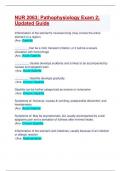
Exam 2)NUR 2063: Pathophysiology Exam 2; Updated Guide; Questions & Answers: Guaranteed APlus Guide
Inflammation of the stomach's mucosal lining (may involve the entire stomach or a region) (Ans- Gastritis _________Can be a mild, transient irritation, or it cab be a severe ulceration with hemorrhage (Ans- Acute Gastritis _________ Usually develops suddenly and is likely to be accompanied by nausea and epigastric pain (Ans- Acute Gastritis _________ Gastritis develops gradually. (Ans- Chronic Gastritis Gastritis can be further categorized as erosive or nonerosive (Ans- Ch...
- Package deal
- Examen
- • 30 páginas •
Inflammation of the stomach's mucosal lining (may involve the entire stomach or a region) (Ans- Gastritis _________Can be a mild, transient irritation, or it cab be a severe ulceration with hemorrhage (Ans- Acute Gastritis _________ Usually develops suddenly and is likely to be accompanied by nausea and epigastric pain (Ans- Acute Gastritis _________ Gastritis develops gradually. (Ans- Chronic Gastritis Gastritis can be further categorized as erosive or nonerosive (Ans- Ch...
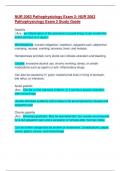
NUR 2063 Pathophysiology Exam 2: NUR 2063 Pathophysiology Exam 2 Study Guide: Updated Solution
Gastritis (Ans - an inflammation of the stomachs mucosal lining. It can involve the entire stomach or a region. Manifestations: Include indigestion, heartburn, epigastric pain, abdominal cramping, nausea, vomiting, anorexia, fever, and malaise. Hematemesis and dark, tarry stools can indicate ulceration and bleeding. Causes: excessive alcohol use, chronic vomiting, stress, or certain medications such as aspirin or anti- inflammatory drugs. Can also be caused by H. pylori- bacteri...
- Package deal
- Examen
- • 33 páginas •
Gastritis (Ans - an inflammation of the stomachs mucosal lining. It can involve the entire stomach or a region. Manifestations: Include indigestion, heartburn, epigastric pain, abdominal cramping, nausea, vomiting, anorexia, fever, and malaise. Hematemesis and dark, tarry stools can indicate ulceration and bleeding. Causes: excessive alcohol use, chronic vomiting, stress, or certain medications such as aspirin or anti- inflammatory drugs. Can also be caused by H. pylori- bacteri...
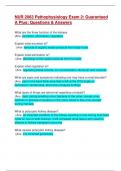
Exam 2 )NUR 2063: Pathophysiology Exam 2: Guaranteed A Plus: Questions & Answers: Updated Solution
What are the three function of the kidneys (Ans- excretion, elimination, regulation Explain what excretion is? (Ans- removal of organic waste products from body fluids Explain what elimination is? (Ans- discharge of the waste products from the body Explain what regulation is? (Ans- regulating blood volume, ion concentration, blood pH and nutrients What are signs and symptoms indicating one may have a renal disorder? (Ans- pain in the back flank area that is felt at the CV...
- Package deal
- Examen
- • 24 páginas •
What are the three function of the kidneys (Ans- excretion, elimination, regulation Explain what excretion is? (Ans- removal of organic waste products from body fluids Explain what elimination is? (Ans- discharge of the waste products from the body Explain what regulation is? (Ans- regulating blood volume, ion concentration, blood pH and nutrients What are signs and symptoms indicating one may have a renal disorder? (Ans- pain in the back flank area that is felt at the CV...
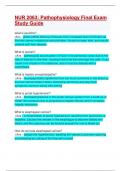
NUR 2063: Pathophysiology Final Exam Study Guide: Updated APlus Guide Solution
what is jaundice? (Ans - green yellow staining of tissues from increased level of bilirubin as the liver cannot metabolize extra bilirubin. Found on eyes, skin, and mouth. present with liver disease What is ascites? (Ans - pathological accumulation of fluid in the peritoneal cavity due to the loss of albumin in the liver, causing fluid to be free amongst the cells. It can cause a lot of pain in the abdomen, and it must be drained with a parenthesis What is hepatic encephalopathy? (An...
- Package deal
- Examen
- • 39 páginas •
what is jaundice? (Ans - green yellow staining of tissues from increased level of bilirubin as the liver cannot metabolize extra bilirubin. Found on eyes, skin, and mouth. present with liver disease What is ascites? (Ans - pathological accumulation of fluid in the peritoneal cavity due to the loss of albumin in the liver, causing fluid to be free amongst the cells. It can cause a lot of pain in the abdomen, and it must be drained with a parenthesis What is hepatic encephalopathy? (An...

NR509 Week 5 Quiz: Questions & Answers: Latest Updated
Final Exam) NSG 527 Questions & Answers: Study Guide Updated A Plus Guide Solution
Test Bank for Success in Practical Vocational Nursing 9th Edition by Knecht: Success in Practical Vocational Nursing 9th Edition by Knecht: Guaranteed A+ Guide
Lewis Medical Surgical Nursing, 10th Edition:Test Bank - Lewis Medical Surgical Nursing, 10th Edition: 100 % Verified Question & Answers( Chapters 1-68): Guaranteed A+
ANCC FNP Board Questions & Answers: Latest Updated A+ Guide